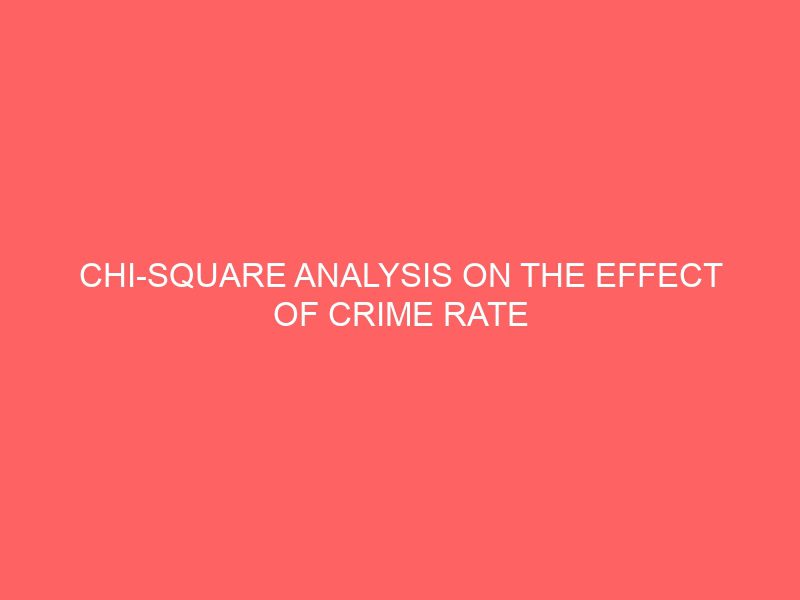Description
CHAPTER ONE 1.1 BACKGROUND OF STUDY Crime is like other concepts in social sciences, which have no generally accepted definition. According to Oxford Dictionary of Sociology (2009), ?a crime is held to be an offence, which goes beyond the personal and into the public sphere, breaking prohibitory rules or laws, to which legitimate punishments or sanctions are attached, and which requires the intervention of a public authority? for crime to be known as such, it must come to the notice of, and be processed through, an administrative system or enforcement agency. It must be reported and recorded by the police (or other investigator); it may then become part of criminal statistics; may or may not be investigated; and may or may not result in a court case.? Dambazau (1994) defined crime as an act or omission against public interest and which is prescribed by law enacted by the legislature in the overall interests of the society, and to which prescribed punishment is attached in the event of violation and it involves four major principles which are public wrong, moral wrong, law and punishment for the criminal. Crime is also seen as a violation of the rules agreed to be respected by all members of the society, and upon which the rest members of the society mete sanction upon those guilty of the violation. It is for the same reason that the legal system views crime as a public and moral wrong. The prevalence of crime in the world today is a cause for serious concern for all and sundry. It undermines the social fabric by eroding the sense of safety and security. Crime impacts on society in a variety of ways according to the nature and extent of crime committed. It constitutes a problem when its incidence is as rampant in the society as to constitute a threat to the security of persons and property, as well as social order and solidarity (Onoge, 1998). Crime is a threat to the economic, political and social security of a nation and a major factor associated with underdevelopment; because it discourages both local and foreign investments, reduces the quality of life, destroys human and social capital, damages relationship between citizens and the states, thus undermining democracy, rule of law and the ability of the country to promote development. The development in societies with particular references to westernization has not helped matters; instead, it has been destructive to the social and cultural values of the society. Reasons for the increase in crime in Nigeria include urbanization which is spreading more widely and rapidly than improvement in the social and economic condition. Crime is a huge threat to public safety. Our study focus only on a State (Oyo State) in Nigeria. In categorizing crimes, crime do varies even within States of a nation. For instance, in Nigeria today (2003-till date), Bombing, Terrorism, Suicide bombing, Religion war& killings, vandalism etc., is a crime peculiar in the Northern part of Nigeria particularly in the states like Borno, Adamawa, Kano and Yobe whereas, Kidnapping, Pipeline vandalism, Armed robbery and Oil theft are order of the day in Niger-Delta part of Nigeria. In the South west and in the Eastern part of Nigeria, we have heard of cases of Ritual killing, Theft &Stealing, Kidnapping, Assaults, Wounding, Armed robbery etc. 1.2 RESEARCH QUESTIONS ? Research Question 1: What is the nature of crime commonly committed in the state ? Research Question 2: Which local government of the state has the highest crime rate ? Research Question 3: Which age group is more involved in the criminal activities most ? 1.3 SIGNIFICANCE OF THE STUDY The significance of this study is mainly to ascertain the level of crime in Oyo state, to know if crime is age, gender related. Another importance of this study is to know if there is a relationship between crime and educational background, to discover which age group is more involved in criminal activities. Another very cardinal significance of this study is to know the frequently committed crimes in Oyo state and causes. 1.4 SCOPE OF STUDY This study is centered on the statistical analysis of the crime offenses recorded in Oyo state. Another scope of the study is to know if crime in Oyo state is age and gender related. Thirdly, to know the frequently committed crimes in Oyo state. 1.5 LIMITATIONS OF THE STUDY It is necessary to mention some of the limitations in this research work. The chief limitation is the difficulty in obtaining relevant information in that a few of our values gotten from the police divisional headquarters Oyo state were missing but these missing values were not statistical significant enough to be noticed. Another limitation is the difficulty in administering questionnaire and retrieving in that respondents were not prompt in filling out the questionnaire. Notwithstanding, in the highlighted limitation above, it is hoped that this research will be useful to Oyo state and the general public. 1.6 BRIEF ABOUT THE CASE STUDY Nigeria?s southwestern state of Oyo calls itself Nigeria?s ?pace setter,? reflecting a deeply held pride in the state?s reputation as a leader in the fields of commerce and education. Oyo?s capital city of Ibadan is one of the largest commercial centers in West Africa. But in recent years, Oyo has also pushed the frontiers of violence and corruption that characterize Nigeria?s nascent ?democracy.? This is where democracy starts in Nigeria. Everything started here. But the situation is deteriorating and now we have a government of illiterates, we have a politics of hooliganism, of violence, of moneybags. 1.7 DEFINITION OF TERMS Crime: activities that involve breaking the law. Criminal: the illegal act of somebody or group of people failing to do something that they should do. It also means connected with or involving crime. Criminal activity: an act committed in violation of the law where the consequences of conviction by a court are punishment, especially where the punishment is a serious one such as imprisonment. 1.6.1 RESEARCH HYPOTHESES The research hypotheses are as follows: HYPOTHESIS 1 H0: there is no significant relationship between age and criminal offences in Oyo state. H1: there is a significant relationship between age and criminal offences in Oyo state Level of significance: 0.05 Decision rule: reject H0 if p-value is less than the level of significance. Accept H0 if otherwise. HYPOTHESIS 2 H0: there is no significant relationship between gender and criminal offences in Oyo state. H1: there is a significant relationship between gender and criminal offences in Oyo state Level of significance: 0.05 Decision rule: reject H0 if p-value is less than the level of significance. Accept H0 if otherwise. HYPOTHESIS 3 H0: there is no significant relationship between educational background and criminal offences in Oyo state H1: there is no significant relationship between educational background and criminal offences in Oyo state. Level of significance: 0.05 Decision rule: reject H0 if p-value is less than the level of significance. Accept H0 if otherwise of the reports of their victimization?







